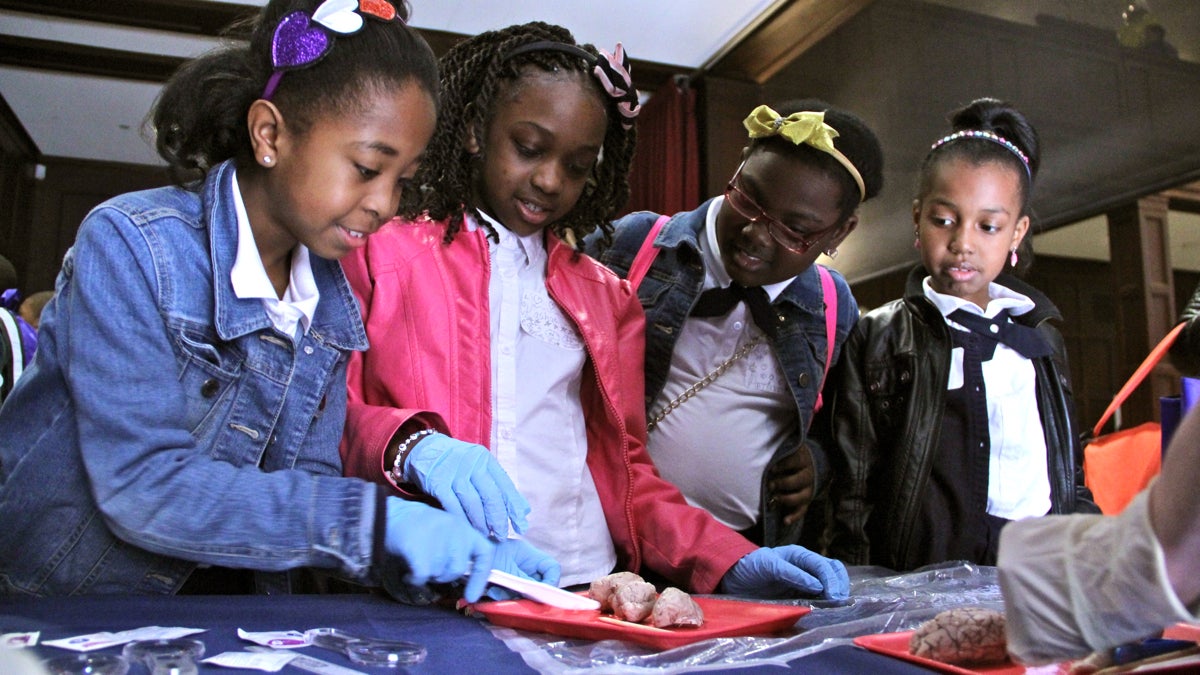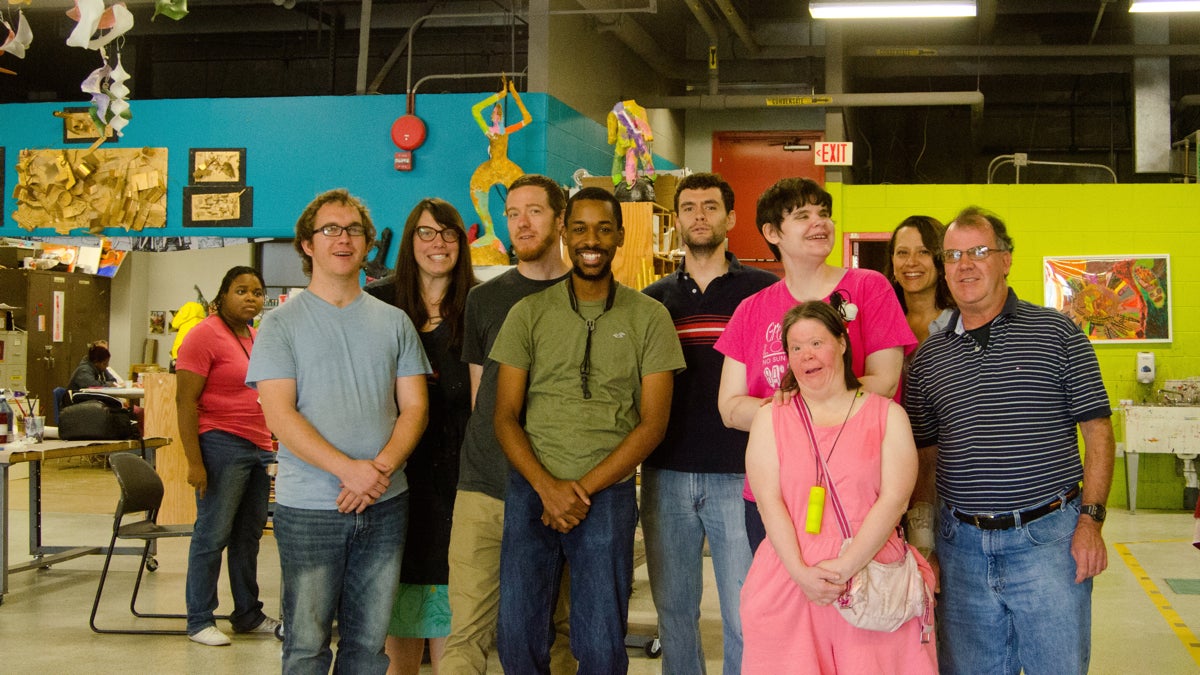Scientists learn to talk to kids about STEM in Philadelphia
Listen
Third graders from Cornerstone Christian Academy (from left) Marenda Robinson, Kashae Livingston, Arianna Cox, and Milan Byrd, disect a sheep's brain during a science fair at the University of Pennsylvania. (Emma Lee/WHYY)
Understanding the art of explaining science to kids.
“Do one of you want to cut the brain?” asks graduate student Carolyn Keating, as third graders, Kashae Livingston and Kennedy Prophet, simultaneously respond with a resounding “Yes!”
The girls have on blue latex gloves, and they’re waiting for Keating to hand over the scalpel.
Keating prepped sheep brains for dissection and quizzed the girls as they turned the sample into minced meat.
“The front of your brain—the frontal lobe—do you guys know what that does?”
One girl guesses: “Helps you see?” “Close.” Keating said, but not quite.
“You do a lot of decision making with your frontal lobe,” she said.
About a hundred elementary school students attended a science fair at the University of Pennsylvania in April. At “The Switcheroo” event, the elementary-age kids were the judges and older students from the University’s neuroscience department talked about the kid-friendly experiments they had designed.
The idea is to make the kids better scientists and make the scientists better communicators.
The girls in Kennedy and Kashae’s group—from Cornerstone Christian Academy—were a swirl of pink backpacks, pleated skirts and flower hair accessories as they moved from one table to the next. The students learned about the sense of smell, the importance of bike helmets and why a cat’s cerebellum is so big.
(Answer: The cerebellum is responsible for coordination, balance and motor skills, and because cats are so agile, they constantly use and build that ‘muscle.’)
Educators are looking for ways to get more children to fall in love with science, technology, engineering and mathematics—in hopes that they will launch careers in those fields later in life.
Lots of young girls are excited about STEM, but that interest often fades as they become adolescents and teens. Experts say today’s high school computer classes and physics labs are dominated by boys.
But if kids are bored and uninterested, maybe it’s us, not them. Lots of scientists are not very good at explaining their work in layman’s terms. So science evangelists are now teaching adults how to better communicate with children.
Only one of the four eight-year-old students knew who Bill Nye the Science Guy was, and according to her, he’s “not so cool. “I don’t really know people who do science, I just like it,” she added.
If you want them to pay attention, the girls suggest you get pop star Beyoncé or one of their favorite teen idols to talk with them about molecular fusion or engineering.
Skai Jackson, Peyton List, Cameron Boyce—all actors on the Disney Channel–are favorites.
At the science fair, one demonstration was set up like an air hockey game. The kids shuttled balls back and forth to show how nerve cells in the brain communicate.
College senior Sheila Shankar was behind the table. She’s a double major and a member of the University of Pennsylvania’s Neuroscience Honor Society. You could not ask for a better science role model for young girls.
But when she first started explaining the science–her answer was peppered with the terms “neurotransmitter,” “vesicles,” “synaptic cleft” and “post synaptic cleft.”
Then, Shankar started again and shared the answer she prepared for the kids.
“Say that you’re on a cell phone, and you want to communicate with your friend who has another cell phone. You would send your friend a text message, which is like a neuron sending neurotransmitters to another neuron,” Shankar said.
Every year, there’s a contest in New York that gives adults a chance to practice talking that way with children. The Flame Challenge at Stony Brook University asks scientists to explain a simple concept in way that engages an 11 year old.
The first winner was a guy named Benjamin Ames who was studying quantum optics. He submitted a tongue-twister of a song about ‘pyrolysis’ and ‘chemiluminescence.’
Four years later Christine O’Connell can still sing the song—and she remembers the science concepts it explains.
O’Connell is associate director of the Alan Alda Center for Communicating Science, which hosts the contest. Founder Alan Alda was fascinated by fire when he was a boy and asked his teacher “What is a flame?”
“Her answer to him was ‘oxidation.’ And that didn’t satisfy his curiosity at all, that made him more confused,” O’Connell said.
Some scientists get caught up in “academic speak.” Good explainers say just enough and leave young students a little bit curious, she said. Stony Brook teaches workshops on how to do that.
“A lot of what we do is based in improvisation and teaching scientists improvisation games and techniques, which is all about connecting to the person you are talking to, getting out of your own head, putting the focus on them,” O’Connell said.
Past contestants have had success with animated videos and fancy editing but sometimes the winner is the scientist who simply stands in front of a camera and uses the most vivid words.
Every year the kids give the scientists constructive criticism.
O’Connell says one boy told them: ‘it’s OK to be funny; it’s not OK to be silly. We’re 11, we’re not 7.”
This year’s contest question is: “What is sound?”
Tens of thousands of 11 year olds around the world are reviewing three videos and three written answers from the finalists.
“Keeping it interactive is always a good idea,” said finalist and college physics teacher Nick Weckesser.
Weckesser says he’s an introvert but when he puts on his YouTube persona—and calls himself Nick Lucid, he’s different. In his explainer video, Nick Lucid shrinks down to take kids on a deep dive tour of the inner ear, and he never gets lost in jargon.
“Instead of jumping right in and talking about waves and using words like frequency, I had to start talking about things vibrating or wiggling,” he said.
That might be the best advice for aspiring science communicators: there’s power in words like ‘wiggle.’ And repetition is good. Weckesser’s 2:41 minute video includes the word wiggle no less than 20 times.
Winners of the 2016 Flame Challenge will be announced June 5 at the World Science Festival in New York. The prize is $1,000 and a trip to the festival.

Mike Kaplan, lecturer in the biological basis of behavior at the University of Pennsylvania, uses the inner workings of a piano to illustrate the way sound reaches the brain. (Emma Lee/WHYY)
WHYY is your source for fact-based, in-depth journalism and information. As a nonprofit organization, we rely on financial support from readers like you. Please give today.



